More: Local Photography • Local Interviews • Previews • Columns & Features • Blogs • Roster • About • Contact
Interview: Fur Peace Ranch
Jorma and Vanessa Kaukonen discuss their 24-year-old music farm
Jorma and Vanessa Kaukonen discuss their 24-year-old music farm
I didn't read the directions on how to approach Fur Peace Ranch from the north on Route 33 and I ended up missing
the exit that I was supposed to take. Rather, I exited onto 20 when it intersected 33 farther south and was given a tour
of the countryside that eventually led me to the entrance. Like a summer camp entrance, the driveway weaved its way
to an open lot in front of cabins and large log buildings. I parked near the trees with others who had already arrived.
The Psylodelic Gallery had opened its doors for the official start of the Wes Wilson showing, a collection of vintage
concert posters created during the height of the 60’s scene, most notably for Bill Graham of The Fillmore in San
Francisco. The gallery itself is a silo converted into a two story circular gallery.
The first floor is home to items from the 60s, notably the typewriter form the Janis Joplin and Jorma Kaukonen
typewriter tapes, Wavy Gravies sleeping bag from Woodstock and some of Jorma’s clothing and jewelry from the time.
Stairs spiraled up around the side to the second story, which was home to the concert poster show consisting primarily
of Wes Wilson posters, all of which were owned by Jorma. The room was a open and circular with tie die beanbag
chairs lining the wall. On the ceiling was a projected movie featuring photos and a liquid light show.
There were a few of us lounging around on the second story sharing facts about what we were observing and learning
from each other’s stories. Once you planted in one of those chairs you weren't getting up for a while. Eventually I found
my way outside and found Wes Wilson himself standing in a gazebo to the right of the silo. He was signing posters and
talking to fans about his techniques and life of making posters in the 60s.
I met Jerry Sullivan who is Jorma’s current neighbor and good friend. He took me around the facilities and showed me
the grounds--the cabins, the dining hall, and the offices. I told him I was here for the opening, interviews and the show
later that evening that would feature The Jerry Miller & Terry Haggerty Band. He then introduced me to ranch manager
John Hurlbut, Hurl for short. Hurl was helping fans get parked and checking stubs when he told me to walk up to
Jorma and get things started.
Jorma is an easygoing, approachable man. I saw him meeting with fans near the venue's front, which was right next to
the gallery. The scene was casual and really cool in the sense that he was just hanging around. My initial goal was to
talk about the gallery, considering this was the second show of the year and a new thing for this part of the Ohio area
and the ranch.
the exit that I was supposed to take. Rather, I exited onto 20 when it intersected 33 farther south and was given a tour
of the countryside that eventually led me to the entrance. Like a summer camp entrance, the driveway weaved its way
to an open lot in front of cabins and large log buildings. I parked near the trees with others who had already arrived.
The Psylodelic Gallery had opened its doors for the official start of the Wes Wilson showing, a collection of vintage
concert posters created during the height of the 60’s scene, most notably for Bill Graham of The Fillmore in San
Francisco. The gallery itself is a silo converted into a two story circular gallery.
The first floor is home to items from the 60s, notably the typewriter form the Janis Joplin and Jorma Kaukonen
typewriter tapes, Wavy Gravies sleeping bag from Woodstock and some of Jorma’s clothing and jewelry from the time.
Stairs spiraled up around the side to the second story, which was home to the concert poster show consisting primarily
of Wes Wilson posters, all of which were owned by Jorma. The room was a open and circular with tie die beanbag
chairs lining the wall. On the ceiling was a projected movie featuring photos and a liquid light show.
There were a few of us lounging around on the second story sharing facts about what we were observing and learning
from each other’s stories. Once you planted in one of those chairs you weren't getting up for a while. Eventually I found
my way outside and found Wes Wilson himself standing in a gazebo to the right of the silo. He was signing posters and
talking to fans about his techniques and life of making posters in the 60s.
I met Jerry Sullivan who is Jorma’s current neighbor and good friend. He took me around the facilities and showed me
the grounds--the cabins, the dining hall, and the offices. I told him I was here for the opening, interviews and the show
later that evening that would feature The Jerry Miller & Terry Haggerty Band. He then introduced me to ranch manager
John Hurlbut, Hurl for short. Hurl was helping fans get parked and checking stubs when he told me to walk up to
Jorma and get things started.
Jorma is an easygoing, approachable man. I saw him meeting with fans near the venue's front, which was right next to
the gallery. The scene was casual and really cool in the sense that he was just hanging around. My initial goal was to
talk about the gallery, considering this was the second show of the year and a new thing for this part of the Ohio area
and the ranch.


Written By, Photos By ZANE A. MILLER
| OOTB PUBLICATIONS | OOTB646.COM |
| Local & National Entertainment Coverage Since 2001. For The Fans, By The Fans. |
Founded in 1989 by guitarist Jorma Kaukonen (Hot Tuna, Jefferson Airplane) and his wife
Vanessa, Fur Peace Ranch located in Meigs County, Ohio offers year-round guitar, bass and
songwriting workshops from renowned musicians including GE Smith, Jack Casady Bill Kirchen,
and many others. The ranch also offers live concert events and a one-of-a-kind silo featuring
art and memorabilia from The Psychedelic Era titled "Psylodelic Gallery."
Vanessa, Fur Peace Ranch located in Meigs County, Ohio offers year-round guitar, bass and
songwriting workshops from renowned musicians including GE Smith, Jack Casady Bill Kirchen,
and many others. The ranch also offers live concert events and a one-of-a-kind silo featuring
art and memorabilia from The Psychedelic Era titled "Psylodelic Gallery."
Fur Peace Ranch is located at 39495
St. Clair Road in Pomeroy, Ohio 45769.
Visit online for more information at
www.furpeaceranch.com.
St. Clair Road in Pomeroy, Ohio 45769.
Visit online for more information at
www.furpeaceranch.com.
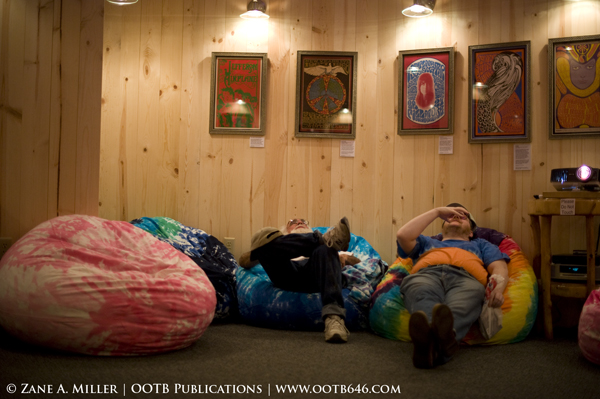

The ranch itself has been here for quite a few years, teaching some 3,000 players how to play music while hosting
some big name teachers in the music industry like Bill Nershi, George Porter and Jorma himself. I found myself talking
with Jorma about many aspects of music past and present along with future plans for Hot Tuna, solo studio
accomplishments and Fur Peace Ranch.
THE JORMA KAUKONEN INTERVIEW
Zane: I’m not sure where to even start. Too much cool stuff going on here.
Jorma: Well, gosh.
Zane: I guess it seems that this event is all about The Psylodelic Gallery and the Wes Wilson showing. Seems to pair
really nicely with what you guys have set up tonight for the concert.
Jorma: You know we were so excited when… We didn’t even know that Jerry [Miller] and Terry [Hagerty] were touring
again, but Johnny Hurlbut. I don’t know if you met him or not, but he is the one who puts all the music events together.
When I heard they were touring I said we got to get these guys. So to get them both together is a real treat.
Zane: It really sort of reaches back to the time really well. So, I guess with having Wes Wilson here, how do you tend
to relate what he does with what you do?
Jorma: Well you know, it’s an interesting coexistence because you know, Wes is a graphic artist of course and we’re
musicians, but when things began to happen in San Francisco and they didn't just start off happening in '65. They sort
of evolved. But things began to start happening and the Avalon Ballroom and all these other places and guys like Wes
who were a little bit older than the rest of us. You know, you think about a guy like him. To be a graphic artist that just
doesn't look like as much fun to me as playing the guitar, because there is a lot of work involved in that and these guys
are so good and the stuff they did with the posters as the scene evolved, they were sort of inextricably intertwined and
it's hard to explain, but it’s hard to imagine a Fillmore show without seeing one of the posters that goes along with it,
you know. Some of these posters are so iconic you know, like the ones with the Butterfield Blues Band and the
Jefferson Airplane and the Grateful Dead. I mean all these things you know. I’d be lying if I said, “oh yeah I remember
this show,” because I don’t remember that show, because it was a long time ago. But I do remember those posters.
That’s how I remember that stuff. Oh yeah, that was that poster
Zane: That ‘s pretty excellent. So I was reading an interview that discussed the creation of the silo and how you guys
were attempting to create something that wasn't quite like a fine art presentation, but rather a capturing of an era.
Jorma: Right. Well exactly, and one of the things also, and I don’t know how guys like Wes would you know, how some
of the artists would respond to this, but in a way the concept of fine arts and what they are doing and what they did, it
certainly is fine arts but the concept of fine arts per say sort of like went against the grain of the sort of loose aspects
of the scene. I mean the guys, you know, these artist were doing this sort of multi-colored silk screens and stuff.
That’s time-consuming stuff and music of course is something of the moment. To see these two things sort of
inextricably bound in some way, you know, like who knows how long it takes a guy like Wes to do a poster and we to
be sure, the band rehearsed all the time. But you know, the music performance, it happens and then it’s gone.
The posters are still here. But in any case it is just so interesting that after all these years the memories are so
powerful, and here is something that is interesting also. When Vanessa [Kaukonen] came up with the idea of doing
The Psylodelic Gallery, you know, all the stuff that happened, happened a long time ago, and because it was just a
part of guys like me all our life it’s kind of hard to really put it into perspective that those moments have some
importance to somebody else and that’s one of the things that she said, “we need to do this” and I’m like “what for?”
It’s just like we did this, we did that, and she’s like, “no you did this and you did that, but the retelling of it is what is
important to the people in the present” and that was sort of a tough concept to grapple with because it’s like, who
really cares what we did fifty years ago. But the answer is, some people do and it was an exciting time and that is
what matters among the other things also. I was talking to Terry Haggerty about it earlier. Music is not dead. There are
a lot of fantastic musicians. The bar is always getting raised with musical performance and guitar players. I mean it’s
evolving constantly, as it should, but one of the things that I think we were lucky about, you know, when I was young
back in those times is that the music and the art and the written word and all this kind of stuff was incredibly powerful
because it was so closely related to important events of the time, with the Vietnam War, whether it was marching for
racial equality, all this kind of stuff. We don’t have anything like that today. We have other things to get involved with
I mean, don’t get me wrong. I’m not saying we don’t have anything going on today. We've got tons of stuff going on
today, but it was a simpler time and these issues were so clear cut and their reality had a lot to do with the art and the
music and the written word, etcetera, that was going on so all these things happened simultaneously. Now I think when
we talk about them in retrospect you look back at the history. I mean, I look back at it and I go, "that was a really
exciting time." It was a really exciting time. I’m sure your time is exciting to you now, but it was different you know, and
a lot of the stuff was relevant to do with the social upheaval of the time.
Zane: Well, I kind of get the sense that a lot more people were, I guess, a lot more tuned into what was going on issue
wise than they tend to be now.
Jorma: Right, well I think it was easier. I think the issues were a little bit more clear-cut in a lot of ways. I mean we live
in complicated times and it really, it’s a different ball of wax. The issues in my recollection were really pretty clear-cut
you know. Whether you were for or against the Vietnam War, you didn't have to put that in a lot of different ways. You
were either for it or you were against it, you know. It was as simple as that. It’s not like you now, should we go into
Syria, do we not go into Syria, if you do this will that happen. I mean things are just much more complex today.
Zane: Well, did you tend to notice that people were… I mean like you said, the people were either on or off a curtain
issue. Did you run into like a group apathy sort of perspective on things?
Jorma: I graduated from college in 1965 and the school that I graduated from was the University of Santa Clara.
I remember my dad used to complain about 1500 bucks a semester tuition. It's 50 grand now. I was probably one of the
two strangest guys in the school at the time and I’m not that strange, you know. It was very conservative, so a lot of the
people I knew… like my first roommate there was the president of the young republicans club and he was conservative
even by republican standards. I mean this guy was very conservative and the two of us together was hysterically funny
when I look back on it. But I don’t remember seeing a lot of apathy. I mean you were either one side or you were on the
other side. There weren't many people that I knew who just plain didn't care.
Zane: In your discussion of having things happen at the time with music for reasons that happen on the spot, do you
find that tends to be how you’re driven to makes studio recordings nowadays?
Jorma: Well, everybody’s creative process is a little bit different. For me I have written a lot of songs over the years,
but I’m not a tunesmith. I don’t write songs for a living. I just don’t crank them out, so for me two things make me write
songs. Something that happens in my life that stimulates me, that says you need to write a song about this. Like for
example, I was on a road trip a month or so ago. We were in Harrisburg, Pennsylvania and as I was waking up, this
line came to me and this line was “we never seem to change in my dreams” and I woke up. And before I did anything
like I do and email, which is a spirit killer for being creative, any of that kind of stuff. I sat down and got my guitar out
and I actually wrote a song in it’s entirety you know. So that’s something that sort of called out to me. The other way
that I work with stuff is I do a project every four or five years, a Jorma project, and the last Hot Tuna project before was
something like 20 years ago. We’re going to try not to wait that long this time. I’m deadline driven, so once I’ve
committed myself to doing something, if I haven’t finished all the songs I make myself do it. So I know I can do it, I just
don’t like to do that. So I guess the two things that approach me, something could happen to me, it could be a line, a
verbal line, it could be a musical line that I just immediately intuitively feel this could go somewhere and be a song.
Or, I have to write a bunch of songs so I lock myself away to sit down and write a bunch of songs and some of them
make the cut and some of them don’t.
Zane: So the other thing too is with your classes that go on here frequently during the summer, I have noticed that you
have these amazing guest instructors. Do you sort of relate to how it is put together kind of in a way that might be
similar to like the event of the typewriter tapes (spontaneous) or is it more of a case where you reach out to them or
they reach out to you?
Jorma: It works both ways, sometimes they reach out to us and sometimes we reach out to them. Before the economic
crunch hit three or four years ago, we could afford to be really daring with our instructors and we did really well
because people had more money to throw around. Right now with the fiscal climate being the way it is, we can’t be as
adventuresome as we were before because we have to sell the classes, you know. But you never know what’s going
to work. I mean you know it wouldn't be a creative business if you could predict exactly what was going to happen.
We have Bill Nershi. He has been here twice. Fabulous player. Great guy. The first time he was here he didn't have a
lot of students even though he is a well-known player. The second time he was here his class was packed, so
sometimes I like to take chances with people. I say, "I love this guy," maybe it is not going to make it this time, but we’ll
make it the next time we’ll have him. Not every great artist likes to teach, so it’s really a challenge for us to find the
ones that we love that also love to teach. [Someone] like my buddy John Hammond, we sort of grew up together
playing guitar. Great, really great fantastic blues guy and he’s breathtaking, but he can’t verbalize what it is he does.
We had him for a class and when I learned how to play the guitar the guys that I learned from teach the way John did,
they didn't talk about chord names, or shapes, or keys, or time signatures, or counting. They just said, "Here’s how it
goes," and we’d scurry off into the corner and practice and go, "how’s that?" and they’d go,“that sucks! I told you this is
how it goes.” Well, we don’t teach that way. It makes it a lot easier to explain what you’re doing. The people who are
coming to this ranch, they aren't like me. We'd would go through anything we had to [in order] to learn it. It didn't matter
how the people taught it. I knew the information was there and we had to find a key or someway to get it. Most of the
people that come to the ranch they like to be, and I don’t mean this in a demeaning way, like to be spoon feed a little
more than when I was a kid with learning how to play. And that’s OK, so we need to find the guys that not only are
great artists, but can explain what it is they do.
Zane: Do you find that pulling in these different instructors allow you to grow personally?
Jorma: Oh, absolutely.
Zane: I guess you guys are trading stuff all the time.
Jorma: Oh sure, sure.
Zane: I’m sure you guys are, with collaborations and everything that's amazing for getting new ideas.
Jorma: I mean like both Terry and Jerry are very sophisticated players. If you’re familiar with their work you already
know it. When we see them play they use a lot of really harmonically sophisticated chord shades and stuff like that
and its still rock and roll, but it’s tricky stuff. So for me to hang out with guys like them, I’m going to be able to snag a
couple of chords off them. But it’s not just the instructors that bring me sort of outside my comfort zone. All the students
do too. I mean there is always some guy that does something… “ah, let me see that, let me check that out.” I did a
song writing class here earlier this year, there was a Vietnam vet from Chillicothe that came here. He’d never written a
song before and he wrote this song… “Beneath the green maples the great spirit sins. Helicopter seeds twirling down
on the winds” and it just goes on and on. It was such a cool song and it was in waltz time and I said when I do my next
album I’m going to record that song. So, that’s one song I don’t have to write because this guy already wrote it and he
never wrote a song before. But you never know when something good is going to pop up.
Zane: You've got Jefferson Airplane and then it disbands to Hot Tuna, and then it seems like a lot of your more recent
work has been more folk and blues roots.
Jorma: Right
Zane: What draws you to that rather then the electric scene?
Jorma: I started out by playing acoustic guitar. And I did have an electric guitar in high school and I did play it.
The electric guitar back then was an amplified guitar rather then an electric guitar. I didn't know any of the tricks and
stuff we take for granted today, like feedback and the noise. It was just a guitar, but louder. I started learning how to
finger pick from these guys that I was going to school with in Antioch. And I hadn't really planned on playing electric
stuff at all and I sort of got snookered into playing with the Airplane and of course you know, I owe all those guys and
gals such a huge debt of gratitude because they opened my eyes to a lot of stuff. It was an interesting band. Airplane
wasn't a typical rock and roll band. They wrote really interesting songs and as sort of a folky finger stile guitar player
coming into it, I had no idea what to do. We rehearsed endlessly. I mean that’s all we did. We either rehearsed or we
gigged. They would keep playing these songs over and over again and I had a chance to figure out what it is that I did
on those recordings so I really had on-the-job training to do that kind of stuff. And when Jack and I sort of opted out of
the Airplane and began Hot Tuna, we started out doing some acoustic stuff. But electric music is very seductive, it’s a
lot of fun and all this kind of stuff so we got caught up in doing all that and we did that for a number of years. I love
both of them [electric and acoustic]. I think my heart is more closely attached to the acoustic music probably because
that’s how I started and I like the fact that even though I get to play with a lot of great guys when I play acoustic, I can
go home and play by myself. I would never go home and play lead guitar at home by myself. I need people to play
with. I've never practiced licks and stuff without playing with other people because I don’t think it’s fun. A lot of people
do and that’s how they get to be real good at it. I've got my thing as an electric guitar player, but in my opinion I know
what my limits are with it you know. I mean, you’ll see these guys tonight, their boundaries are very, very wide, but in
any case, I like them both. I think I like the acoustic stuff better because it seems a little more up close and personal
I think from an artistic point of view. Whether I am actually playing solo or playing with Barry Mitterhoff, my mandolin
playing buddy, or having Jack [Casady] or something like that. But I like the electric stuff too. I don't like carrying that
[electric] shit around. Like I brought the amps over for the guys and I'm like, "these things are heavy."
Zane: [laughs] Yeah a fender twin can get pretty…
Jorma: A fender twin is just about as obnoxious as it gets. Terry and I were talking and I remember when I was, I guess
I wasn't that young. I was 24 or 25. We just started with Airplane, we started to make some money. I had two fender
twins and I lived on a third floor walk up. I remember being able to carry those things up three flights of stairs, one in
each hand. That’s not going to be happening again any time soon.
Zane: And a guitar on the back?
Jorma: Man those twins, boy are they heavy. Of course we didn't have road cases for them back then, so that was a
step in the right direction. When we used to travel around, you know, when you get an amp sometimes they come with
like a slipcover that covers it up. The plastic thing, that’s all we had. I would put the slipcover on, check it on the
airplane and be there to catch it when it came down the carousel where they unloaded, just like luggage.
Zane: So, why Ohio? I mean this part of Ohio is amazing. I’m just curious.
Jorma: It is amazing. I’m a big booster of the state of Ohio anyway. I really think it’s a great state. I've lived in a lot of
places and I've traveled a lot. Obviously southeast Ohio, as you know, it’s a special place. I just lucked into this. I had
gone to Antioch College. My grandfather lives in Cincinnati. I got my first earache in 1950 at the Jewish community
center in Cincinnati. I've got family that lives up in Fairport that have lived up there for a hundred years. But, that’s not
why I came here. This guy calls me up out of the blue in '89 or '90 and says, "I've got this piece of property, the Fur
Peace Ranch. It’s 116 acres. I want 32 grand for it." Well, 32 grand in 1990 was a little less, I mean it was a little more
than today’s dollars. But I came down and looked at it. It was a crummy winter, you know how winters can be down
here. It wasn't even romantic. It was wintery mix, muddy, grey, you know the deal. Well, I just had a good feeling about
it so I bought it, my wife thought I had lost my mind. We came down here and there was nothing. We built all this stuff
here. There was poison ivy and multi floral rose up here. And I rented a place up in Harrisonville which is up over the
other side of 33 and there’s like 70 or 80 something acres there and a little farmhouse and when we first moved here,
I don’t know if they still do this. They had this land contract thing when you buy and sell land in Ohio where basically
the guy you’re selling it to carries the paper for you, so you just give him money down and you do a thing and instead
of paying the bank you pay him. I couldn't say no, so we bought that farm too you know, and it just turned out to be the
right thing. I mean the climate down here, the mental and spiritual climate is great. I've adjusted to the weather so that
wintery mix doesn’t bother my anymore and on a day like today, it’s just beautiful, so it was the right move for us to
make. When I moved to upstate New York, not very far up, just above Woodstock. At Woodstock, that part of the area,
the Adirondacks, it’s beautiful, and it looks like country, but it’s really not country. Everything’s really expensive.
It’s really a bedroom community for the city. And when I moved down here I could feel the difference immediately.
I like country. I like country living and I travel around all the time, so I see plenty of everything, but when I first moved
here things were a little bit more rustic than they are now, but we have Athens right up the road. We can get movies
and get pizza you know. Now you can do that down here, but at the time there wasn't much down here. But, it was just
the right move for us. I think it’s a great place to raise kids. I’m sure my kids are going to take off and go, but they can
always come back.
Zane: Do you see this brain child of yours growing larger?
Jorma: You know, I don’t know if you talked to Vanessa or not or if you’re going to talk to Vanessa, but she's really the
brains behind all this whole thing. She was a civil engineer before we got married so she knew how to do the designs
and get permits and stuff like that. And it was her idea to do the silo and the theatre and all this stuff. We've sort of
been doing things as time goes along. Physically I don’t see it getting bigger in terms of more cabins and more
students because I like the fact that when people are here for a week I can actually remember everybody’s names
before the weekends over.
Zane: Well when you've got 3,000 plus names to remember…
Jorma: John Hurlbut, the man that works as the ranch manager, he remembers all those names. It’s unbelievable.
If we played black jack, we’d be taking him to the casinos and he’d be counting cards for us, but I, I don’t see it
physically getting any bigger. There’s always something else that will pop up. But from a teaching point of view. I like
it being this size because the classes are small. It stays manageable. Now if the economy turns around and we can
start to be a little more daring as I said earlier in this conversation, where we are going to have more instructors, we’re
going to have to think enlarging it just because we have more instructors. But in the light of the way things are now,
I don’t see it getting any bigger.
Zane: Have you ever done a music festival here?
Jorma: We’ve never done one here. A friend of mine has a festival over at Hosen Lake in Athens county. He’s had
a bluegrass festival for 30 years. That’s tricky stuff. I don’t see us doing that. I don’t close the door on it because you
never know, but I've worked at a lot of festivals. I talk to a lot of people about this. There’s so much liability and
logistics that need to be taken into consideration when you're going to do stuff like that. I mean you really can’t leave
things to chance and so I don’t see that happening today, but you never know.
some big name teachers in the music industry like Bill Nershi, George Porter and Jorma himself. I found myself talking
with Jorma about many aspects of music past and present along with future plans for Hot Tuna, solo studio
accomplishments and Fur Peace Ranch.
THE JORMA KAUKONEN INTERVIEW
Zane: I’m not sure where to even start. Too much cool stuff going on here.
Jorma: Well, gosh.
Zane: I guess it seems that this event is all about The Psylodelic Gallery and the Wes Wilson showing. Seems to pair
really nicely with what you guys have set up tonight for the concert.
Jorma: You know we were so excited when… We didn’t even know that Jerry [Miller] and Terry [Hagerty] were touring
again, but Johnny Hurlbut. I don’t know if you met him or not, but he is the one who puts all the music events together.
When I heard they were touring I said we got to get these guys. So to get them both together is a real treat.
Zane: It really sort of reaches back to the time really well. So, I guess with having Wes Wilson here, how do you tend
to relate what he does with what you do?
Jorma: Well you know, it’s an interesting coexistence because you know, Wes is a graphic artist of course and we’re
musicians, but when things began to happen in San Francisco and they didn't just start off happening in '65. They sort
of evolved. But things began to start happening and the Avalon Ballroom and all these other places and guys like Wes
who were a little bit older than the rest of us. You know, you think about a guy like him. To be a graphic artist that just
doesn't look like as much fun to me as playing the guitar, because there is a lot of work involved in that and these guys
are so good and the stuff they did with the posters as the scene evolved, they were sort of inextricably intertwined and
it's hard to explain, but it’s hard to imagine a Fillmore show without seeing one of the posters that goes along with it,
you know. Some of these posters are so iconic you know, like the ones with the Butterfield Blues Band and the
Jefferson Airplane and the Grateful Dead. I mean all these things you know. I’d be lying if I said, “oh yeah I remember
this show,” because I don’t remember that show, because it was a long time ago. But I do remember those posters.
That’s how I remember that stuff. Oh yeah, that was that poster
Zane: That ‘s pretty excellent. So I was reading an interview that discussed the creation of the silo and how you guys
were attempting to create something that wasn't quite like a fine art presentation, but rather a capturing of an era.
Jorma: Right. Well exactly, and one of the things also, and I don’t know how guys like Wes would you know, how some
of the artists would respond to this, but in a way the concept of fine arts and what they are doing and what they did, it
certainly is fine arts but the concept of fine arts per say sort of like went against the grain of the sort of loose aspects
of the scene. I mean the guys, you know, these artist were doing this sort of multi-colored silk screens and stuff.
That’s time-consuming stuff and music of course is something of the moment. To see these two things sort of
inextricably bound in some way, you know, like who knows how long it takes a guy like Wes to do a poster and we to
be sure, the band rehearsed all the time. But you know, the music performance, it happens and then it’s gone.
The posters are still here. But in any case it is just so interesting that after all these years the memories are so
powerful, and here is something that is interesting also. When Vanessa [Kaukonen] came up with the idea of doing
The Psylodelic Gallery, you know, all the stuff that happened, happened a long time ago, and because it was just a
part of guys like me all our life it’s kind of hard to really put it into perspective that those moments have some
importance to somebody else and that’s one of the things that she said, “we need to do this” and I’m like “what for?”
It’s just like we did this, we did that, and she’s like, “no you did this and you did that, but the retelling of it is what is
important to the people in the present” and that was sort of a tough concept to grapple with because it’s like, who
really cares what we did fifty years ago. But the answer is, some people do and it was an exciting time and that is
what matters among the other things also. I was talking to Terry Haggerty about it earlier. Music is not dead. There are
a lot of fantastic musicians. The bar is always getting raised with musical performance and guitar players. I mean it’s
evolving constantly, as it should, but one of the things that I think we were lucky about, you know, when I was young
back in those times is that the music and the art and the written word and all this kind of stuff was incredibly powerful
because it was so closely related to important events of the time, with the Vietnam War, whether it was marching for
racial equality, all this kind of stuff. We don’t have anything like that today. We have other things to get involved with
I mean, don’t get me wrong. I’m not saying we don’t have anything going on today. We've got tons of stuff going on
today, but it was a simpler time and these issues were so clear cut and their reality had a lot to do with the art and the
music and the written word, etcetera, that was going on so all these things happened simultaneously. Now I think when
we talk about them in retrospect you look back at the history. I mean, I look back at it and I go, "that was a really
exciting time." It was a really exciting time. I’m sure your time is exciting to you now, but it was different you know, and
a lot of the stuff was relevant to do with the social upheaval of the time.
Zane: Well, I kind of get the sense that a lot more people were, I guess, a lot more tuned into what was going on issue
wise than they tend to be now.
Jorma: Right, well I think it was easier. I think the issues were a little bit more clear-cut in a lot of ways. I mean we live
in complicated times and it really, it’s a different ball of wax. The issues in my recollection were really pretty clear-cut
you know. Whether you were for or against the Vietnam War, you didn't have to put that in a lot of different ways. You
were either for it or you were against it, you know. It was as simple as that. It’s not like you now, should we go into
Syria, do we not go into Syria, if you do this will that happen. I mean things are just much more complex today.
Zane: Well, did you tend to notice that people were… I mean like you said, the people were either on or off a curtain
issue. Did you run into like a group apathy sort of perspective on things?
Jorma: I graduated from college in 1965 and the school that I graduated from was the University of Santa Clara.
I remember my dad used to complain about 1500 bucks a semester tuition. It's 50 grand now. I was probably one of the
two strangest guys in the school at the time and I’m not that strange, you know. It was very conservative, so a lot of the
people I knew… like my first roommate there was the president of the young republicans club and he was conservative
even by republican standards. I mean this guy was very conservative and the two of us together was hysterically funny
when I look back on it. But I don’t remember seeing a lot of apathy. I mean you were either one side or you were on the
other side. There weren't many people that I knew who just plain didn't care.
Zane: In your discussion of having things happen at the time with music for reasons that happen on the spot, do you
find that tends to be how you’re driven to makes studio recordings nowadays?
Jorma: Well, everybody’s creative process is a little bit different. For me I have written a lot of songs over the years,
but I’m not a tunesmith. I don’t write songs for a living. I just don’t crank them out, so for me two things make me write
songs. Something that happens in my life that stimulates me, that says you need to write a song about this. Like for
example, I was on a road trip a month or so ago. We were in Harrisburg, Pennsylvania and as I was waking up, this
line came to me and this line was “we never seem to change in my dreams” and I woke up. And before I did anything
like I do and email, which is a spirit killer for being creative, any of that kind of stuff. I sat down and got my guitar out
and I actually wrote a song in it’s entirety you know. So that’s something that sort of called out to me. The other way
that I work with stuff is I do a project every four or five years, a Jorma project, and the last Hot Tuna project before was
something like 20 years ago. We’re going to try not to wait that long this time. I’m deadline driven, so once I’ve
committed myself to doing something, if I haven’t finished all the songs I make myself do it. So I know I can do it, I just
don’t like to do that. So I guess the two things that approach me, something could happen to me, it could be a line, a
verbal line, it could be a musical line that I just immediately intuitively feel this could go somewhere and be a song.
Or, I have to write a bunch of songs so I lock myself away to sit down and write a bunch of songs and some of them
make the cut and some of them don’t.
Zane: So the other thing too is with your classes that go on here frequently during the summer, I have noticed that you
have these amazing guest instructors. Do you sort of relate to how it is put together kind of in a way that might be
similar to like the event of the typewriter tapes (spontaneous) or is it more of a case where you reach out to them or
they reach out to you?
Jorma: It works both ways, sometimes they reach out to us and sometimes we reach out to them. Before the economic
crunch hit three or four years ago, we could afford to be really daring with our instructors and we did really well
because people had more money to throw around. Right now with the fiscal climate being the way it is, we can’t be as
adventuresome as we were before because we have to sell the classes, you know. But you never know what’s going
to work. I mean you know it wouldn't be a creative business if you could predict exactly what was going to happen.
We have Bill Nershi. He has been here twice. Fabulous player. Great guy. The first time he was here he didn't have a
lot of students even though he is a well-known player. The second time he was here his class was packed, so
sometimes I like to take chances with people. I say, "I love this guy," maybe it is not going to make it this time, but we’ll
make it the next time we’ll have him. Not every great artist likes to teach, so it’s really a challenge for us to find the
ones that we love that also love to teach. [Someone] like my buddy John Hammond, we sort of grew up together
playing guitar. Great, really great fantastic blues guy and he’s breathtaking, but he can’t verbalize what it is he does.
We had him for a class and when I learned how to play the guitar the guys that I learned from teach the way John did,
they didn't talk about chord names, or shapes, or keys, or time signatures, or counting. They just said, "Here’s how it
goes," and we’d scurry off into the corner and practice and go, "how’s that?" and they’d go,“that sucks! I told you this is
how it goes.” Well, we don’t teach that way. It makes it a lot easier to explain what you’re doing. The people who are
coming to this ranch, they aren't like me. We'd would go through anything we had to [in order] to learn it. It didn't matter
how the people taught it. I knew the information was there and we had to find a key or someway to get it. Most of the
people that come to the ranch they like to be, and I don’t mean this in a demeaning way, like to be spoon feed a little
more than when I was a kid with learning how to play. And that’s OK, so we need to find the guys that not only are
great artists, but can explain what it is they do.
Zane: Do you find that pulling in these different instructors allow you to grow personally?
Jorma: Oh, absolutely.
Zane: I guess you guys are trading stuff all the time.
Jorma: Oh sure, sure.
Zane: I’m sure you guys are, with collaborations and everything that's amazing for getting new ideas.
Jorma: I mean like both Terry and Jerry are very sophisticated players. If you’re familiar with their work you already
know it. When we see them play they use a lot of really harmonically sophisticated chord shades and stuff like that
and its still rock and roll, but it’s tricky stuff. So for me to hang out with guys like them, I’m going to be able to snag a
couple of chords off them. But it’s not just the instructors that bring me sort of outside my comfort zone. All the students
do too. I mean there is always some guy that does something… “ah, let me see that, let me check that out.” I did a
song writing class here earlier this year, there was a Vietnam vet from Chillicothe that came here. He’d never written a
song before and he wrote this song… “Beneath the green maples the great spirit sins. Helicopter seeds twirling down
on the winds” and it just goes on and on. It was such a cool song and it was in waltz time and I said when I do my next
album I’m going to record that song. So, that’s one song I don’t have to write because this guy already wrote it and he
never wrote a song before. But you never know when something good is going to pop up.
Zane: You've got Jefferson Airplane and then it disbands to Hot Tuna, and then it seems like a lot of your more recent
work has been more folk and blues roots.
Jorma: Right
Zane: What draws you to that rather then the electric scene?
Jorma: I started out by playing acoustic guitar. And I did have an electric guitar in high school and I did play it.
The electric guitar back then was an amplified guitar rather then an electric guitar. I didn't know any of the tricks and
stuff we take for granted today, like feedback and the noise. It was just a guitar, but louder. I started learning how to
finger pick from these guys that I was going to school with in Antioch. And I hadn't really planned on playing electric
stuff at all and I sort of got snookered into playing with the Airplane and of course you know, I owe all those guys and
gals such a huge debt of gratitude because they opened my eyes to a lot of stuff. It was an interesting band. Airplane
wasn't a typical rock and roll band. They wrote really interesting songs and as sort of a folky finger stile guitar player
coming into it, I had no idea what to do. We rehearsed endlessly. I mean that’s all we did. We either rehearsed or we
gigged. They would keep playing these songs over and over again and I had a chance to figure out what it is that I did
on those recordings so I really had on-the-job training to do that kind of stuff. And when Jack and I sort of opted out of
the Airplane and began Hot Tuna, we started out doing some acoustic stuff. But electric music is very seductive, it’s a
lot of fun and all this kind of stuff so we got caught up in doing all that and we did that for a number of years. I love
both of them [electric and acoustic]. I think my heart is more closely attached to the acoustic music probably because
that’s how I started and I like the fact that even though I get to play with a lot of great guys when I play acoustic, I can
go home and play by myself. I would never go home and play lead guitar at home by myself. I need people to play
with. I've never practiced licks and stuff without playing with other people because I don’t think it’s fun. A lot of people
do and that’s how they get to be real good at it. I've got my thing as an electric guitar player, but in my opinion I know
what my limits are with it you know. I mean, you’ll see these guys tonight, their boundaries are very, very wide, but in
any case, I like them both. I think I like the acoustic stuff better because it seems a little more up close and personal
I think from an artistic point of view. Whether I am actually playing solo or playing with Barry Mitterhoff, my mandolin
playing buddy, or having Jack [Casady] or something like that. But I like the electric stuff too. I don't like carrying that
[electric] shit around. Like I brought the amps over for the guys and I'm like, "these things are heavy."
Zane: [laughs] Yeah a fender twin can get pretty…
Jorma: A fender twin is just about as obnoxious as it gets. Terry and I were talking and I remember when I was, I guess
I wasn't that young. I was 24 or 25. We just started with Airplane, we started to make some money. I had two fender
twins and I lived on a third floor walk up. I remember being able to carry those things up three flights of stairs, one in
each hand. That’s not going to be happening again any time soon.
Zane: And a guitar on the back?
Jorma: Man those twins, boy are they heavy. Of course we didn't have road cases for them back then, so that was a
step in the right direction. When we used to travel around, you know, when you get an amp sometimes they come with
like a slipcover that covers it up. The plastic thing, that’s all we had. I would put the slipcover on, check it on the
airplane and be there to catch it when it came down the carousel where they unloaded, just like luggage.
Zane: So, why Ohio? I mean this part of Ohio is amazing. I’m just curious.
Jorma: It is amazing. I’m a big booster of the state of Ohio anyway. I really think it’s a great state. I've lived in a lot of
places and I've traveled a lot. Obviously southeast Ohio, as you know, it’s a special place. I just lucked into this. I had
gone to Antioch College. My grandfather lives in Cincinnati. I got my first earache in 1950 at the Jewish community
center in Cincinnati. I've got family that lives up in Fairport that have lived up there for a hundred years. But, that’s not
why I came here. This guy calls me up out of the blue in '89 or '90 and says, "I've got this piece of property, the Fur
Peace Ranch. It’s 116 acres. I want 32 grand for it." Well, 32 grand in 1990 was a little less, I mean it was a little more
than today’s dollars. But I came down and looked at it. It was a crummy winter, you know how winters can be down
here. It wasn't even romantic. It was wintery mix, muddy, grey, you know the deal. Well, I just had a good feeling about
it so I bought it, my wife thought I had lost my mind. We came down here and there was nothing. We built all this stuff
here. There was poison ivy and multi floral rose up here. And I rented a place up in Harrisonville which is up over the
other side of 33 and there’s like 70 or 80 something acres there and a little farmhouse and when we first moved here,
I don’t know if they still do this. They had this land contract thing when you buy and sell land in Ohio where basically
the guy you’re selling it to carries the paper for you, so you just give him money down and you do a thing and instead
of paying the bank you pay him. I couldn't say no, so we bought that farm too you know, and it just turned out to be the
right thing. I mean the climate down here, the mental and spiritual climate is great. I've adjusted to the weather so that
wintery mix doesn’t bother my anymore and on a day like today, it’s just beautiful, so it was the right move for us to
make. When I moved to upstate New York, not very far up, just above Woodstock. At Woodstock, that part of the area,
the Adirondacks, it’s beautiful, and it looks like country, but it’s really not country. Everything’s really expensive.
It’s really a bedroom community for the city. And when I moved down here I could feel the difference immediately.
I like country. I like country living and I travel around all the time, so I see plenty of everything, but when I first moved
here things were a little bit more rustic than they are now, but we have Athens right up the road. We can get movies
and get pizza you know. Now you can do that down here, but at the time there wasn't much down here. But, it was just
the right move for us. I think it’s a great place to raise kids. I’m sure my kids are going to take off and go, but they can
always come back.
Zane: Do you see this brain child of yours growing larger?
Jorma: You know, I don’t know if you talked to Vanessa or not or if you’re going to talk to Vanessa, but she's really the
brains behind all this whole thing. She was a civil engineer before we got married so she knew how to do the designs
and get permits and stuff like that. And it was her idea to do the silo and the theatre and all this stuff. We've sort of
been doing things as time goes along. Physically I don’t see it getting bigger in terms of more cabins and more
students because I like the fact that when people are here for a week I can actually remember everybody’s names
before the weekends over.
Zane: Well when you've got 3,000 plus names to remember…
Jorma: John Hurlbut, the man that works as the ranch manager, he remembers all those names. It’s unbelievable.
If we played black jack, we’d be taking him to the casinos and he’d be counting cards for us, but I, I don’t see it
physically getting any bigger. There’s always something else that will pop up. But from a teaching point of view. I like
it being this size because the classes are small. It stays manageable. Now if the economy turns around and we can
start to be a little more daring as I said earlier in this conversation, where we are going to have more instructors, we’re
going to have to think enlarging it just because we have more instructors. But in the light of the way things are now,
I don’t see it getting any bigger.
Zane: Have you ever done a music festival here?
Jorma: We’ve never done one here. A friend of mine has a festival over at Hosen Lake in Athens county. He’s had
a bluegrass festival for 30 years. That’s tricky stuff. I don’t see us doing that. I don’t close the door on it because you
never know, but I've worked at a lot of festivals. I talk to a lot of people about this. There’s so much liability and
logistics that need to be taken into consideration when you're going to do stuff like that. I mean you really can’t leave
things to chance and so I don’t see that happening today, but you never know.



After my talk with Jorma he told me that I should talk to Vanessa, his wife, about the gallery since it was her project
from the ground up. She talked of the story behind the idea and the future goals for the gallery along with her goals for
presenting the 60s in the way it was meant to be as a time full of people who needed to speak, through music, writing,
and the arts.
THE VANESSA KAUKONEN INTERVIEW
Zane: This silo is your brainchild.
Vanessa: It is the result of my Type-A madness. I had a very different vision for it when I came up with the idea and it
was really just going to be this kind of tubular building with a liquid light show. It was going to be the world’s largest
psychodeliskope. Every building has a dual purpose, which is why we’re not just a music school. We’re a conference
center and we host yoga retreats. We could do multiple things with all my buildings. If I just had this kind of cylinder
with a liquid light show it would be, you see it once and it’s done, unless you change the light show so, you know I’m
a student of art and I just never believed that I could, mostly because of my lack of credentials.
Zane: [laughs] Credentials and art, it’s kind of a silly thing
Vanessa: Isn't it a silly thing? Thank you. You know, 90 percent of what’s in there is owned by Jorma and of course we
have a lot of other things like Wavy Gravy’s sleeping bag. We've got some jewelry. I've got Grace Slick’s art coming in
December. I've got some more photos on loan from Raul Chaves. All the original Wes Wilson posters are Jorma’s.
Clothing from Jack. Jorma’s clothing. The typewriter from the famous Janis Joplin, Jorma typewriter tapes. I thought
I was a pack rat when I first met him 25 years ago. But you know when something tells you [that] you can’t do
something or it is unlikely... well, if you tell it to someone like me, I'm going to do it.
Zane: That’s pretty excellent.
Vanessa: Yeah, I’m really proud of it and the two girls that helped me, Ally White and Hannah Morgan, they are beyond
dedicated to not only the time period that we are exhibiting, but they are dedicated. Hannah graduated from the
College of Fine Arts and Ally is a French history major with an unbelievable knack for archiving and organizing an art
library. Between the two of them, oh my gosh, I just don’t think it would be what it is. Though I would like to take
100 percent of the credit, I’m just the one that thought it up. The real work happens when you get your team together
and you bounce ideas off of each other and you create shows, and you come up with the cultural package that will
enrich your area. We have so much to talk about with that tiny window in music history because really, the psychedelic
era was very small when you look at it with the whole, but what happened was amazing. An amazing amount of stuff
happened--the literature, the art, the music, the culture, it was just, the story needs to be continually told I think.
Zane: It was a very fiery time in human existence.
Vanessa: Yeah, when you walk in the lobby all those voices are shouting at you, all those quotes. People were
demanding to be heard and they, like every generation, you come out of a generation and you shed the oppression
from whatever the oppression was. It happened in the 20s and the 30s, but something happened from the 50s to the
60s. People were really sick and tired of being told what to think and they demanded to be heard and they sang it,
they painted it, they spoke it, shouted it, they were thrown in jail for it. It was free expression to the ninth degree and
I just think that’s amazing. When you say the 'psychedelic era' to some people the first thing the think of is the drugs.
It’s so not what it was. We’re an alcohol and drug free facility, so you can do a psychedelic gallery and not talk about
that. You know it certainly was a part of it, but it wasn't what it was.
Zane: I was reading about you guys driving around and found, I guess it was a different silo, like a kaleidoscope silo.
Vanessa: It was the world's largest kaleidoscope in upstate New York, designed by a father and son and the whole
kaleidoscope idea was fantastic. The show was shit. I guess this is going to go on record, but it was the most goofy
kind of Americana I’d ever seen in my life. It was a show. It was all in animation, and not Pixar animation. First they
showed Washington, a little cartoon Washington crossing the Delaware and then they talked about the industrial era
and money and then the infrastructure and you’re watching this in 16 different panels over your head and oh wow
there’s Washington and all this shit, and then they get to the sixties and they start playing The Rolling Stones. I don’t
know what era it is and I’m just watching this and I’m starting to groove and then they show 16 different pot leaves and
I’m like, "hmm, that was the sixties?!" And it’s quite, there are other people in the silo and my ranch manager John is
standing next to me and I jab him with my elbow. I go, “this is an OUTRAGE!!!” He’s like, “Calm down, calm down.”
I couldn’t wait to get out. We get out of the silo and there was this African American couple, young, I was probably old
enough to be her mother and they had their two little kids and I wanted to go, “That wasn’t it. That wasn’t the sixties.
Really!” Anyways, I got out. My team is there with me. Bret, my assistant, my daughter when she was five, and John,
and I go “get over here.” We’re in a huddle and I go, “this is shit, this is an outrage. I am going to tell this story. I’m
going to build the worlds larges psychodelescope!” John's like (hands waving in the air), "she’s really gone off her
proverbial edge." It took me two years. I kept saying I was going to build the worlds larges Psychodeliscope and we are
going to be a destination and slowly the more I listen to myself, gradually I’m like, "you crazy woman!" I really wanted to
just tell that story. I mean The Rock and Roll Hall of Fame has got it all sewn up, but they just celebrate rock and roll
and they do have a 60’s section, but I just felt like the stories weren't being told. The art wasn't being shown, the
people weren't having an opportunity to say, "That’s right, that ‘s what I thought. That’s where it came from."
Zane: So it sounds like you guys are going to have different artists
Vanessa: We are. There will be four shows a year. This is our second and we opened in March. The first one was
when we opened it. We had different clothing and some different artwork and so we brought in Melissa May’s artwork
that is over to the left. We changed up the multimedia wall and we have a different show upstairs, so if you have an
opportunity, Hannah will run the show upstairs. It’s like an eight minute installation.
Zane: I think it is amazing. I mean just the posters alone speak to the era so well.
Vanessa: Well I mean, we even have Wes Wilson here to talk to people about the "why’s?" You know, why did he paint
these. What was it that Bill Graham wanted. Did he ask you? Did he commission this? Did you change your style of
art? I mean being able to have a reception is really quite nice. We will have a reception with Grace Slick; however,
Grace’s will be satellite telecast. She will be in Malibu. She doesn’t travel very much anymore so it will be live, but she
will be in Malibu. So we will get to ask her questions and we are very excited about that.
Zane: So this beetle over here… I notice that there is paint out. Are people allowed to just do what they want?
Vanessa: Do what you want. It’s already changed over. There have been a lot of paintings that have been painted
over. The idea was to have a community piece of art where people could come and express themselves and someone
could add to that art work and they could be an ever revolving exhibit.
Zane: Sort of channel that energy? [of the '60s]
Vanessa: Yeah, and we’ll cover it up. We’re putting kind of a open pavilion over it before frost hits. There will be tent
curtains so it will be protected over the winter, but yeah what better way to do that than a beetle.
Zane: Are you going to try and coordinate musical events with gallery events? Music that is more directly connected to
the era? Because tonight is exceptional.
Vanessa: Yes I know, and we, for the opening night we had Steve Earl. We never had Steve here before and though
he did not have a direct connection with that particular show, the idea is to mix cultures, which is what was happening
back then. People were experiencing Tibetan cultures and Native American cultures and they were joining forces,
joining belief systems and complimenting each other in many ways, so why not do that with music? The idea is to
create a cultural space where many people can enjoy what we have. Not everybody is going to like seeing psychedelic
art. You know my husband is 73 years old and I know 73 year olds that would absolutely not dig this at all. And I know
some conservatives that may not get it, but maybe they will. Maybe if they just let their hair down and let their freak flag
fly a little bit. The idea is to just introduce people to a culture that was demanding to be heard. I mean really I don’t
know if there is anything else I can say other than that. I was born in '62, so my older brother and sister were
responsible for the way that I interpreted that time period for sure. I mean that influence, their influence, they were
influenced by the music and the culture and writers and the songs and the art and they in turn passed that on to me.
I was incredibly lucky to be that young and to experience it. I remember being 7 years old and wanting to go to
California. And I had it all planned out. I was going to go in a VW van and I was going to California. If I had a 7-year-
old, I’d be mortified if she thought that. I’d be like, "what do you mean!?!" My daughter wants to live in New York City.
She loves the museums in NYC. She loves the idea that the city never sleeps and she’s excited by that and you know
what, I love that. It was California with me, it’s New York with her. All you do is pass it on.
Zane: I like that theme of passing on through experience.
Vanessa: Yeah. I’m a visual learner. I’m a civil engineer by trade. I struggled to draw my blue prints and it wasn't until
my boss took me out in the field to show me the subdivision and do the water test. Back then you would find the hole
and put a ruler and string and you would measure the drainage by how long it took the water to go down in the hole.
And I remember walking the land and I cam back to my office and my big drafting table and I’m like, I see it now.
And it became much easier for me. Visuals are great.
Zane: I guess that would explain how easily this was created.
Vanessa: Yeah and having two other people work with you, two younger people. It was great. They had a very
different view and they wanted to represent the show in such a way that it would engage their generation.
Zane: That is the interesting thing that I've noticed. It’s dawning on me just from talking to you and Jorma that my
perceptions of the past, they aren't quite what they seem. There is the idealized form of it and through talking with
people who have experience, it is coming clear.
Vanessa: Well, you know the media. Got to love the media. Of course you’re the media but they, it gets portrayed in
a certain way and people think everybody was like Charles Manson and that wasn't it. You know what I mean.
But whatever, like I said, all you can do is show someone and pass off a little piece of your truth and then leave it up
to them I think and then the circle continues and then they pass it on and they bring somebody out and they go, "wow,
it's a cool exhibit" and they bring their friends back and they just stand in the opening hallway of the exhibit and read all
the quotes and they are moved by that. There is a great quote in there by Nixon that is shocking. I believe he believed
it. He was a Quaker and he was talking about peace among the nations and I honestly thought he believed it. He was
a young man when he said that and it was before he became the hated President, you know?
After the interviews I spoke with attendees as we got ready for the concert, which was a great pairing with the gallery
opening and the years represented. The concert featured the Terry Haggerty Band (Sons Of Champlin) with Jerry
Miller (Moby Grape) and Jorma Kaukonen (Jefferson Airplane, Hot Tuna). It was a wonderful day and the show was
great. All in all, if you are going to see music in the Athens area, this is the place to come. You won’t find a more casual
and exclusive scene anywhere without shelling out a big wad of cash. www.furpeaceranch.com
THE LIVE CONCERT
from the ground up. She talked of the story behind the idea and the future goals for the gallery along with her goals for
presenting the 60s in the way it was meant to be as a time full of people who needed to speak, through music, writing,
and the arts.
THE VANESSA KAUKONEN INTERVIEW
Zane: This silo is your brainchild.
Vanessa: It is the result of my Type-A madness. I had a very different vision for it when I came up with the idea and it
was really just going to be this kind of tubular building with a liquid light show. It was going to be the world’s largest
psychodeliskope. Every building has a dual purpose, which is why we’re not just a music school. We’re a conference
center and we host yoga retreats. We could do multiple things with all my buildings. If I just had this kind of cylinder
with a liquid light show it would be, you see it once and it’s done, unless you change the light show so, you know I’m
a student of art and I just never believed that I could, mostly because of my lack of credentials.
Zane: [laughs] Credentials and art, it’s kind of a silly thing
Vanessa: Isn't it a silly thing? Thank you. You know, 90 percent of what’s in there is owned by Jorma and of course we
have a lot of other things like Wavy Gravy’s sleeping bag. We've got some jewelry. I've got Grace Slick’s art coming in
December. I've got some more photos on loan from Raul Chaves. All the original Wes Wilson posters are Jorma’s.
Clothing from Jack. Jorma’s clothing. The typewriter from the famous Janis Joplin, Jorma typewriter tapes. I thought
I was a pack rat when I first met him 25 years ago. But you know when something tells you [that] you can’t do
something or it is unlikely... well, if you tell it to someone like me, I'm going to do it.
Zane: That’s pretty excellent.
Vanessa: Yeah, I’m really proud of it and the two girls that helped me, Ally White and Hannah Morgan, they are beyond
dedicated to not only the time period that we are exhibiting, but they are dedicated. Hannah graduated from the
College of Fine Arts and Ally is a French history major with an unbelievable knack for archiving and organizing an art
library. Between the two of them, oh my gosh, I just don’t think it would be what it is. Though I would like to take
100 percent of the credit, I’m just the one that thought it up. The real work happens when you get your team together
and you bounce ideas off of each other and you create shows, and you come up with the cultural package that will
enrich your area. We have so much to talk about with that tiny window in music history because really, the psychedelic
era was very small when you look at it with the whole, but what happened was amazing. An amazing amount of stuff
happened--the literature, the art, the music, the culture, it was just, the story needs to be continually told I think.
Zane: It was a very fiery time in human existence.
Vanessa: Yeah, when you walk in the lobby all those voices are shouting at you, all those quotes. People were
demanding to be heard and they, like every generation, you come out of a generation and you shed the oppression
from whatever the oppression was. It happened in the 20s and the 30s, but something happened from the 50s to the
60s. People were really sick and tired of being told what to think and they demanded to be heard and they sang it,
they painted it, they spoke it, shouted it, they were thrown in jail for it. It was free expression to the ninth degree and
I just think that’s amazing. When you say the 'psychedelic era' to some people the first thing the think of is the drugs.
It’s so not what it was. We’re an alcohol and drug free facility, so you can do a psychedelic gallery and not talk about
that. You know it certainly was a part of it, but it wasn't what it was.
Zane: I was reading about you guys driving around and found, I guess it was a different silo, like a kaleidoscope silo.
Vanessa: It was the world's largest kaleidoscope in upstate New York, designed by a father and son and the whole
kaleidoscope idea was fantastic. The show was shit. I guess this is going to go on record, but it was the most goofy
kind of Americana I’d ever seen in my life. It was a show. It was all in animation, and not Pixar animation. First they
showed Washington, a little cartoon Washington crossing the Delaware and then they talked about the industrial era
and money and then the infrastructure and you’re watching this in 16 different panels over your head and oh wow
there’s Washington and all this shit, and then they get to the sixties and they start playing The Rolling Stones. I don’t
know what era it is and I’m just watching this and I’m starting to groove and then they show 16 different pot leaves and
I’m like, "hmm, that was the sixties?!" And it’s quite, there are other people in the silo and my ranch manager John is
standing next to me and I jab him with my elbow. I go, “this is an OUTRAGE!!!” He’s like, “Calm down, calm down.”
I couldn’t wait to get out. We get out of the silo and there was this African American couple, young, I was probably old
enough to be her mother and they had their two little kids and I wanted to go, “That wasn’t it. That wasn’t the sixties.
Really!” Anyways, I got out. My team is there with me. Bret, my assistant, my daughter when she was five, and John,
and I go “get over here.” We’re in a huddle and I go, “this is shit, this is an outrage. I am going to tell this story. I’m
going to build the worlds larges psychodelescope!” John's like (hands waving in the air), "she’s really gone off her
proverbial edge." It took me two years. I kept saying I was going to build the worlds larges Psychodeliscope and we are
going to be a destination and slowly the more I listen to myself, gradually I’m like, "you crazy woman!" I really wanted to
just tell that story. I mean The Rock and Roll Hall of Fame has got it all sewn up, but they just celebrate rock and roll
and they do have a 60’s section, but I just felt like the stories weren't being told. The art wasn't being shown, the
people weren't having an opportunity to say, "That’s right, that ‘s what I thought. That’s where it came from."
Zane: So it sounds like you guys are going to have different artists
Vanessa: We are. There will be four shows a year. This is our second and we opened in March. The first one was
when we opened it. We had different clothing and some different artwork and so we brought in Melissa May’s artwork
that is over to the left. We changed up the multimedia wall and we have a different show upstairs, so if you have an
opportunity, Hannah will run the show upstairs. It’s like an eight minute installation.
Zane: I think it is amazing. I mean just the posters alone speak to the era so well.
Vanessa: Well I mean, we even have Wes Wilson here to talk to people about the "why’s?" You know, why did he paint
these. What was it that Bill Graham wanted. Did he ask you? Did he commission this? Did you change your style of
art? I mean being able to have a reception is really quite nice. We will have a reception with Grace Slick; however,
Grace’s will be satellite telecast. She will be in Malibu. She doesn’t travel very much anymore so it will be live, but she
will be in Malibu. So we will get to ask her questions and we are very excited about that.
Zane: So this beetle over here… I notice that there is paint out. Are people allowed to just do what they want?
Vanessa: Do what you want. It’s already changed over. There have been a lot of paintings that have been painted
over. The idea was to have a community piece of art where people could come and express themselves and someone
could add to that art work and they could be an ever revolving exhibit.
Zane: Sort of channel that energy? [of the '60s]
Vanessa: Yeah, and we’ll cover it up. We’re putting kind of a open pavilion over it before frost hits. There will be tent
curtains so it will be protected over the winter, but yeah what better way to do that than a beetle.
Zane: Are you going to try and coordinate musical events with gallery events? Music that is more directly connected to
the era? Because tonight is exceptional.
Vanessa: Yes I know, and we, for the opening night we had Steve Earl. We never had Steve here before and though
he did not have a direct connection with that particular show, the idea is to mix cultures, which is what was happening
back then. People were experiencing Tibetan cultures and Native American cultures and they were joining forces,
joining belief systems and complimenting each other in many ways, so why not do that with music? The idea is to
create a cultural space where many people can enjoy what we have. Not everybody is going to like seeing psychedelic
art. You know my husband is 73 years old and I know 73 year olds that would absolutely not dig this at all. And I know
some conservatives that may not get it, but maybe they will. Maybe if they just let their hair down and let their freak flag
fly a little bit. The idea is to just introduce people to a culture that was demanding to be heard. I mean really I don’t
know if there is anything else I can say other than that. I was born in '62, so my older brother and sister were
responsible for the way that I interpreted that time period for sure. I mean that influence, their influence, they were
influenced by the music and the culture and writers and the songs and the art and they in turn passed that on to me.
I was incredibly lucky to be that young and to experience it. I remember being 7 years old and wanting to go to
California. And I had it all planned out. I was going to go in a VW van and I was going to California. If I had a 7-year-
old, I’d be mortified if she thought that. I’d be like, "what do you mean!?!" My daughter wants to live in New York City.
She loves the museums in NYC. She loves the idea that the city never sleeps and she’s excited by that and you know
what, I love that. It was California with me, it’s New York with her. All you do is pass it on.
Zane: I like that theme of passing on through experience.
Vanessa: Yeah. I’m a visual learner. I’m a civil engineer by trade. I struggled to draw my blue prints and it wasn't until
my boss took me out in the field to show me the subdivision and do the water test. Back then you would find the hole
and put a ruler and string and you would measure the drainage by how long it took the water to go down in the hole.
And I remember walking the land and I cam back to my office and my big drafting table and I’m like, I see it now.
And it became much easier for me. Visuals are great.
Zane: I guess that would explain how easily this was created.
Vanessa: Yeah and having two other people work with you, two younger people. It was great. They had a very
different view and they wanted to represent the show in such a way that it would engage their generation.
Zane: That is the interesting thing that I've noticed. It’s dawning on me just from talking to you and Jorma that my
perceptions of the past, they aren't quite what they seem. There is the idealized form of it and through talking with
people who have experience, it is coming clear.
Vanessa: Well, you know the media. Got to love the media. Of course you’re the media but they, it gets portrayed in
a certain way and people think everybody was like Charles Manson and that wasn't it. You know what I mean.
But whatever, like I said, all you can do is show someone and pass off a little piece of your truth and then leave it up
to them I think and then the circle continues and then they pass it on and they bring somebody out and they go, "wow,
it's a cool exhibit" and they bring their friends back and they just stand in the opening hallway of the exhibit and read all
the quotes and they are moved by that. There is a great quote in there by Nixon that is shocking. I believe he believed
it. He was a Quaker and he was talking about peace among the nations and I honestly thought he believed it. He was
a young man when he said that and it was before he became the hated President, you know?
After the interviews I spoke with attendees as we got ready for the concert, which was a great pairing with the gallery
opening and the years represented. The concert featured the Terry Haggerty Band (Sons Of Champlin) with Jerry
Miller (Moby Grape) and Jorma Kaukonen (Jefferson Airplane, Hot Tuna). It was a wonderful day and the show was
great. All in all, if you are going to see music in the Athens area, this is the place to come. You won’t find a more casual
and exclusive scene anywhere without shelling out a big wad of cash. www.furpeaceranch.com
THE LIVE CONCERT

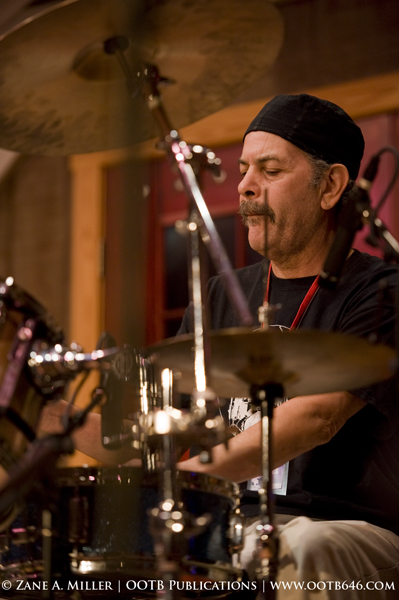




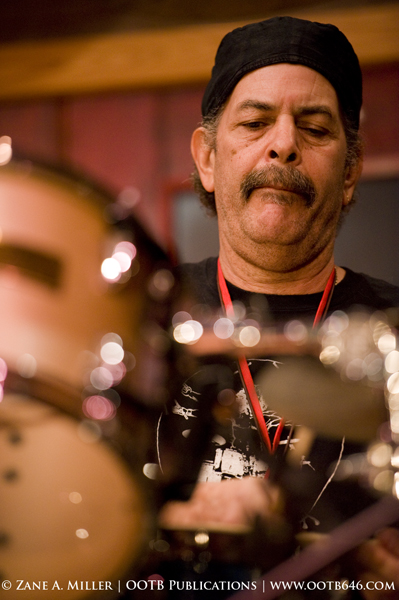






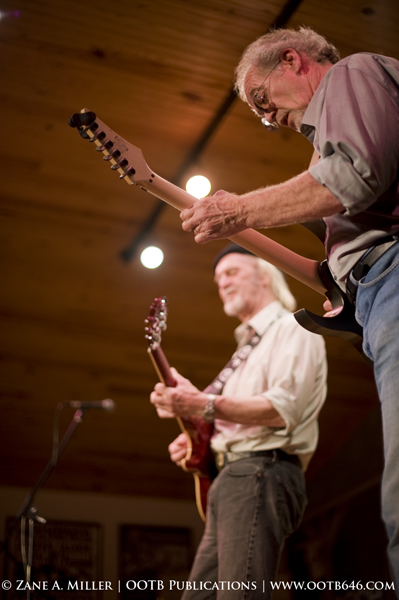






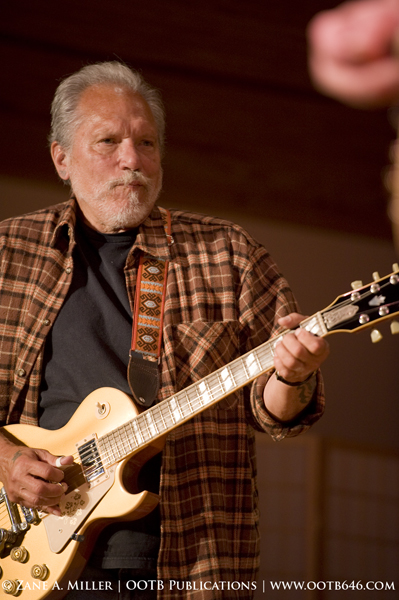





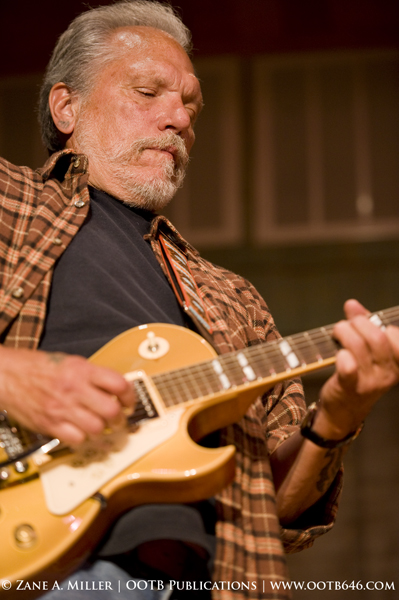



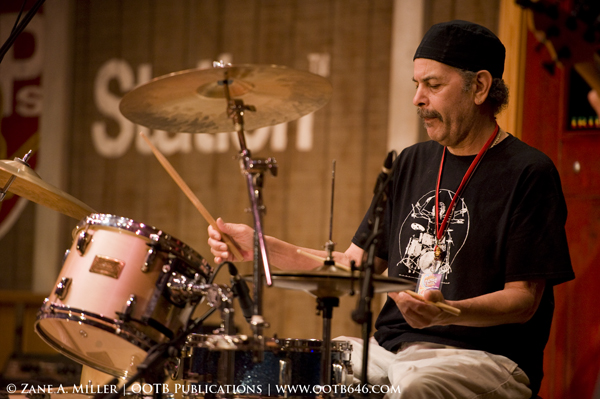






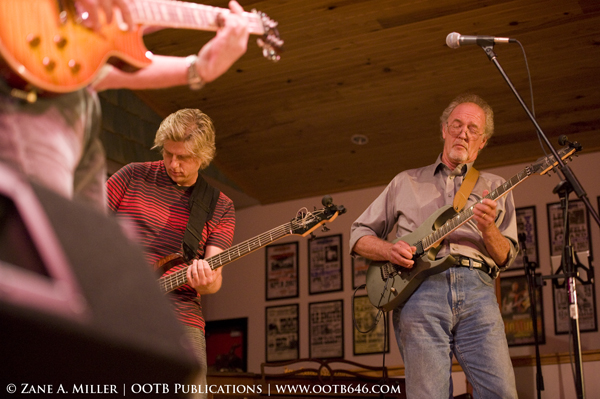







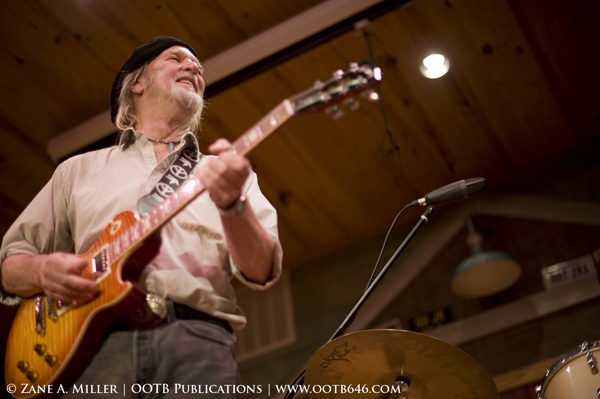


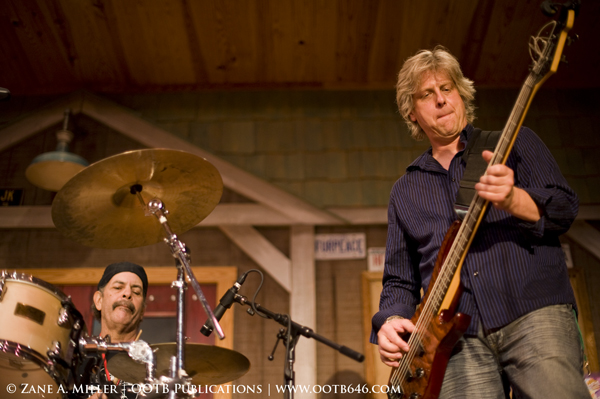
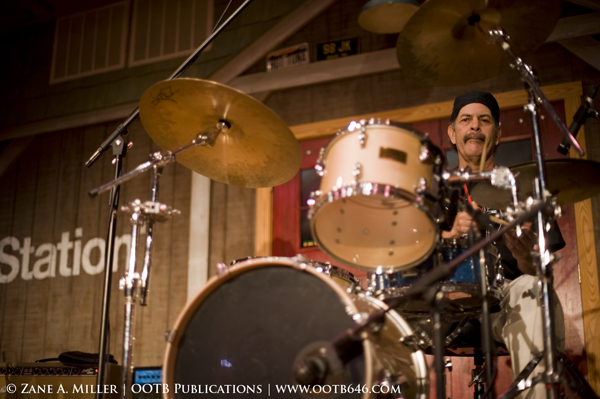

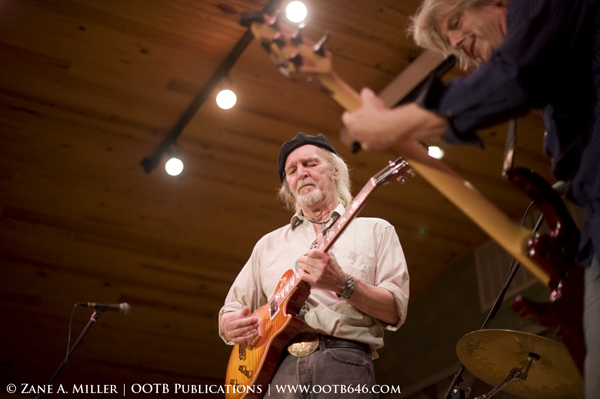


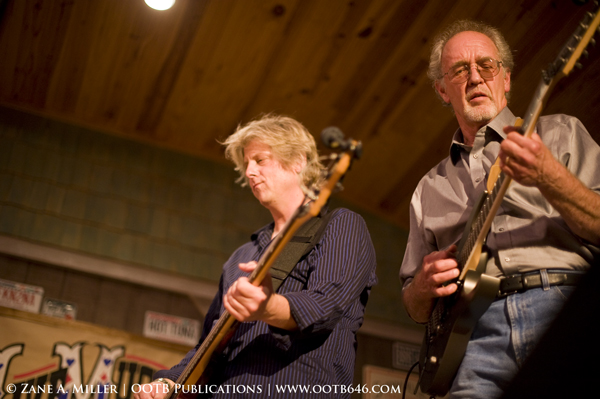




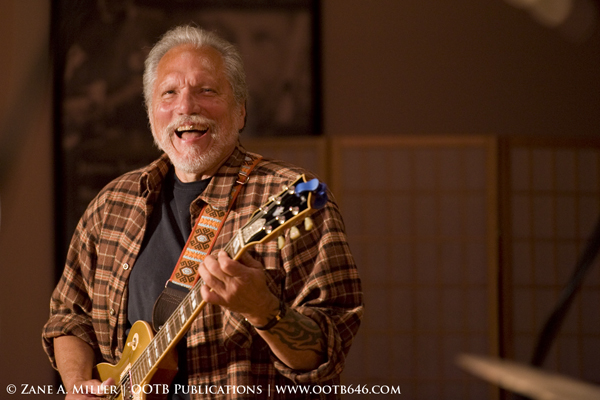








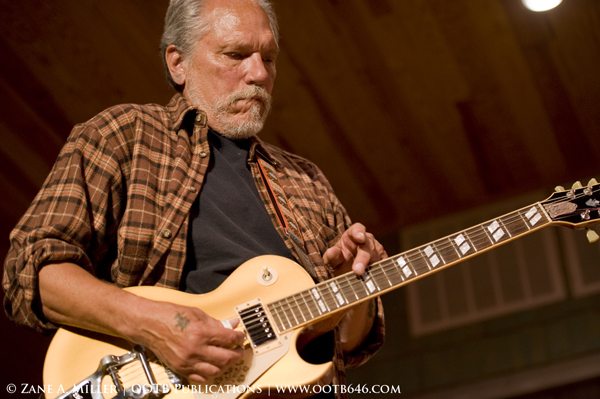



| Out Of The Blue Publications Association, LLC ©Copyright 2001-2013 |
| local scene: PHOTOGRAPHY INTERVIEWS CONCERT REVIEWS ALBUM REVIEWS INDEPENDENT FILM |
| national scene: PHOTOGRAPHY INTERVIEWS CONCERT REVIEWS ALBUM REVIEWS INDEPENDENT FILM |


